Abstract
The new Hexactinellid sponge Chaunoplectella megapora sp. nov. reported in this study was collected from the COMRA contract area, the western part of Clarion-Clipperton Fracture Zone (CCFZ) in the eastern Pacific Ocean at a depth of 5258 m. This sponge’s extraordinary multiporous body with the presence of unique codonhexasters, sigmatocomes, toothed discohexasters and hemidiscohexasters, as well as stellate disocohexasters, characterizes it as a new species in the genus Chaunoplectella. This report presents the first record of family Leucopsacidae at this site in the eastern Pacific Ocean.
References
Amon, D.J., Ziegler, A.F., Dahlgren, T.G., Glover, A.G., Goineau, A., Gooday, A.J., Wiklund, H. & Smith, C.R. (2016) Insights into the abundance and diversity of abyssal megafauna in a polymetallic-nodule region in the eastern Clarion-Clipperton Zone. Sci Rep, 6, 30492.
https://doi.org/10.1038/srep30492Bluhm, H. (1994) Monitoring megabenthic communities in abyssal manganese nodule sites of the East Pacific Ocean in association with commercial deep-sea mining. Aquatic Conservation: Marine and Freshwater Ecosystems, 4, 187–201.
https://doi.org/10.1002/aqc.3270040302Burton, M. (1928) Hexactinellida. Danish Ingolf Expedition, 6, 1–18.
Foell, E.J. & Pawson, D.L. (1986) Photographs of invertebrate megafauna from abyssal depths of the North-Eastern Equatorial Pacific Ocean. Ohio Journal of Science, 86 (3), 61–68.
Ijima, I. (1898) The geneera and species of Rossellidae. Annotationes zoologicae japonenses, 2, 41–55.
Ijima, I. (1903) Studies on the Hexactinellida. Contribution 3.(Placosoma, a New Euplectellid; Leucopsacidae and Caulophacidae). The Journal of the College of Science, Imperial University of Tokyo, Japan, 18, 1–124.
Ijima, I. & Weber, M. (1927) The Hexactinellida of the siboga expedition. Siboga Expedition Reports, 6, 1–383.
Leys, S.P., Mackie, G.O. & Reiswig, H.M. (2007) The Biology of Glass Sponges. Advances in Marine Biology, 52, 1–145.
https://doi.org/10.1016/S0065-2881(06)52001-2
Morgan, C.L., Nichols, J.A., Selk, B.W., Toth, J.R. & Wallin, C. (1993) Preliminary analysis of exploration data from pacific deposits of manganese nodules. Marine Georesources & Geotechnology, 11, 1–25.
https://doi.org/10.1080/10641199309379903Morgan, C.L., Odunton, N.A. & Jones, A.T. (2010) Synthesis of Environmental Impacts of Deep Seabed Mining. Marine Georesources & Geotechnology, 17, 307–356.
http://dx.doi.org/10.1080/106411999273666
Ramirez-Llodra, E., Brandt, A., Danovaro, R., De Mol, B., Escobar, E., German, C.R., Levin, L.A., Martinez Arbizu, P., Menot, L., Buhl-Mortensen, P., Narayanaswamy, B.E., Smith, C.R., Tittensor, D.P., Tyler, P.A., Vanreusel, A. & Vecchione, M. (2010) Deep, diverse and definitely different: unique attributes of the world's largest ecosystem. Biogeosciences, 7, 2851–2899.
https://doi.org/10.5194/bg-7-2851-2010Schulze, F.E. (1887) Report on the Hexactinellida collected by HMS Challenger during the years 1873–1876. Zoology, 21, 1–513.
Tabachnick, K.R. (2002) Family Leucopsacidae Ijima, 1903. In: Systema Porifera. Kluwer Academic/Plenum Publishers, New York, pp.1435–1440.
https://doi.org/10.1007/978-1-4615-0747-5_147Tabachnick, K.R. & Levi, C. (2004) Lyssacinosida du Pacifique sud-ouest (Porifera: Hexactinellida). Mémoires du Muséum national d'histoire naturelle, 191, 11–71.
Topsent, E. (1927) Diagnoses d’éponges nouvelles recueillies par le Prince Albert ler de Monaco. Bulletin de l'Institut océanographique Monaco, 502, 1–19.
Topsent, E.I.A. & Richard, J. (1928) Spongiaires de l'Atlantique et de la Méditerranée, provenant des croisières du Prince Albert 1er de Monaco. Resultats des compagnes scientifiques accomplies par le Prince Albert I. Monaco, 74, 1–376.
Vanreusel, A., Hilario, A., Ribeiro, P.A., Menot, L. & Arbizu, P.M. (2016) Threatened by mining, polymetallic nodules are required to preserve abyssal epifauna. Sci Rep, 6, 26808.
https://doi.org/10.1038/srep26808Wang, C. & Lu, D. (2002) Application of deep ocean photo and video tow system in deep-sea megafaunal studies. Oceanography in China, 14, 74–81. [in Chinese]

